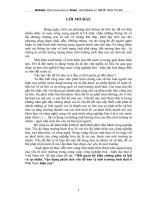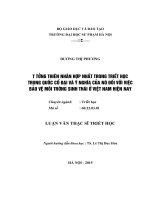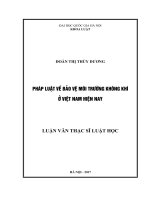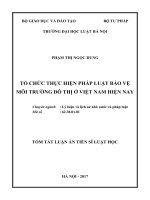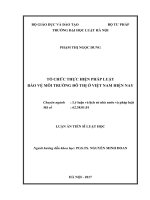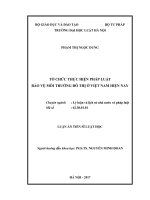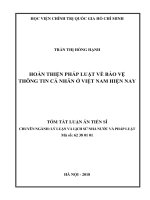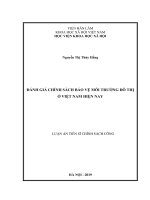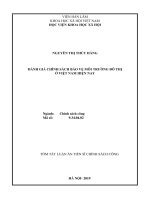Đánh giá chính sách bảo vệ môi trường đô thị ở việt nam hiện nay tt tiếng anh
Bạn đang xem bản rút gọn của tài liệu. Xem và tải ngay bản đầy đủ của tài liệu tại đây (566.35 KB, 27 trang )
VIETNAM ACADEMY OF SOCIAL SCIENCES
GRADUATE ACADEMY OF SOCIAL SCIENCES
NGUYEN THI THUY HANG
EVALUATION RESEARCH ON URBAN ENVIRONMENTAL
PROTECTION POLICY IN VIETNAM
HỢP TÁC XVẬN TÀI THỦY-BỘ
NỘI ĐỊA
Major:
Public Policy
Major Code:
9.34.04.02
SUMMARY OF THE THESIS ON PUBLIC POLICY
HANOI- 2019
The project was completed in:
VIETNAM ACADEMY OF SOCIAL SCIENCES
GRADUATE ACADEMY OF SOCIAL SCIENCES
Supervisor: Assoc.Prof.Dr. Do Phu Hai
Reviewer 1: Assoc.Prof.Dr. Nguyen Huu Hai
Reviewer 2: Assoc.Prof.Dr. Nguyen Chu Hoi
Reviewer 3: Assoc.Prof.Dr. Le Bo Linh
The thesis will be defended against the Thesis Review Board at Graduate Academy
of Social Sciences
At ...... h, Date ....... Month ...... Year ……
The thesis is available on:
- Library of Graduate Academy of Social Sciences
- National library of Vietnam.
LIST OF SCIENTIFIC WORKS OF THE AUTHOR
RELATED TO THE THESIS
1) Nguyen Thi Thuy Hang (2018), Urban environment protection policy
evaluation in Vietnam: Weaknesses and solutions, Journal of Political Sciences, Vol.
5-2018. ISSN 1859-0187, pp. 50-53 & 69.
2) Nguyen Thi Thuy Hang (2018), Urban environment protection policy:
Weaknesses and solutions for sustainable development of the urban system in
Vietnam, Management for Urban Development in Vietnam of the period of year
2008-2018, Construction Publisher, ISBN 978-604-82-2682-4. PP. 210-217.
3) Nguyen Thi Thuy Hang (2018), Methodology for Environmental Policy
Evaluation in the Netherlands and Experiences for Vietnam, Journal of Social
Sciences in Vietnam, Vol. 4-2018. ISSN 1013-4328. PP 42-49.
4) Nguyen Thi Thuy Hang et all (2017), Nuclear power safety policy in the
world and implications for Vietnam, Journal of Social Sciences of Vietnam, Vol 11 2017. ISSN 1013-4328. PP 118-125.
5) Nguyen Thi Thuy Hang et all (2017), Policy Design in the Reduction of
Greenhouse Gas Emission in Vietnam, Vietnam‟s Socio- Economic Development, A
social Science review- No.89, April 2017. ISSN 0868-359X. PP.55-63.
6) Nguyen Thi Thuy Hang et all (2016), Policy instruments for the reduction of
greenhouse gas emission of the period of year 2021-2030 and vision to year 2050 in
Vietnam, International conference of Vietnam study V organized on 15-16th
December 2016 in Hanoi, Vietnam. ID: VS4.011.
1
PREAMBLE
1. Research motivation
The urban environment protection policy (UEPP) plays a key role for
sustainable development. The UEPP is an important attribute of the environment
protection policy in Vietnam which is strongly enforced after the following
Decree 41-NQ/TW dated on 15/11/2004 to protect environment in
industrialization and modernization in Vietnam.
The urban environmental protection policy in Vietnam is constantly being
revised and based on the results of the policy evaluation. However, there are
shortcomings in the policy evaluation as not sufficient and not objective, ensuring the
best policy improvement and improving the efficiency and effectiveness and
appropriate of UEPP. Policy evaluation is the last stage (and post appraisal phase) of
the public policy cycle, and the urban environmental protection policy is the
necessary minor public policy sector that is finalized based on the results of the
policy evaluation fully, objectively and scientifically (Jame Q. Wilson, Do Phu Hai,
2016)
Therefore, it is imperative that theoretical research on environmental protection
policy evaluation, it proposed models and measures to enhance the evaluation of
environmental protection policy, contribute to the improvement of this policy in
Vietnam in the coming time. Research topic "Evaluation research on urban
environmental protection policy in Vietnam" was selected for thesis of the PhD
student.
2. Research objectives and research activities
2.1. Research objectives
Theoretical research was conducted on urban environmental protection policy
evaluation to propose a theoretical model for the urban environmental protection
policy evaluation and measures to improve the effectiveness and efficiency of
environmental protection policy evaluation, contributing to the improvement of urban
environmental protection policy in Vietnam in the coming time.
2.2. Research activities
A theoretical research was done for the evaluation of urban environmental
protection policy, thereby developing a theoretical model for evaluating the urban
environmental protection policy. A practical research was done on the effectiveness
of the evaluation of urban environmental protection policy in Vietnam in the period
of 2005 - 2018 and conducted an empirical test for theoretical model of
environmental protection policy evaluation in Vietnam. The research substantively
proposed models and solutions to improve the effectiveness of environmental
protection policy evaluation in Vietnam.
3. Research unit and scope of research
2
3.1. Research unit
The research was done on theoretical framework and tested in several
chosen cities, so unit analysis is to focus on city to develop the practical model
of urban environmental protection policy evaluation in Vietnam.
3.2. Scope of research
The scope of content: Research on theoretical framework on post-evaluation of
urban environmental protection policy, it developed a theoretical model of urban
environmental protection policy evaluation, did the empirical test within this model
in Vietnam practice, it proposed practical model and solutions for the completion of
urban environmental protection policy evaluation for Vietnam.
The time frame: 2005 -2018.
The spatial scope: The sampling of 06 urban centers in Vietnam includes Ha
Noi, Da Nang, Vinh, Quy Nhon, Lao Cai and Son La city.
4. Theoretical framework and research methodology
4.1. Theoretical framework
The theoretical framework in public policy science includes public policy
theory, public policy cycle, public policy analysis, public policy evaluation,
environmental policy evaluation combined with the ruling Party and State point of
views on urban environmental protection policy evaluation for Vietnam.
4.2. Research methodology
4.2.1. Research approach
The thesis used approaches to parallelize the research tasks set out as follows:
multidisciplinary, multi-sector, systematic, historical, and participatory research.
4.2.2. Research methods
A combination of qualitative research methods and quantitative methods with
their techniques is used as follows: Public policy analysis; method of observation,
participatory research, case study method; multivariate linear regression analysis;
technical analysis, synthesis, comparison. The secondary and secondary data
collection (in-depth interview and questionnaire) are collected. The research
framework is suitable, ensuring the basis for a systematic and logical implementation
of the thesis (Figure 1).
5. New contribution of the thesis
The new contributions are theory development of urban environmental protection
policy; theoretical model development of urban environmental protection policy
evaluation. It is a practical evaluation of urban environmental protection policy in
Vietnam in 2005-2018 and empirical test of model evaluation of public policy in
Vietnam. It interpreted the basic point of views and requirements and proposed a
practical model for urban environmental protection policy evaluation in Vietnam and
solutions to improve this policy evaluation.
3
Figure 1: From theoretical framework analysis to research plan
International
National
Urban areas
Basic conception:
Urban environment
protection policy (UEPP)
Policy instruments
UEPP Evaluation
Theoretical framework
of UEPP evaluation
Theoretical framework
Set up independent variables of the
model of urban environmental
protection policy evaluation
(identification of objective, approach,
methodology, methods, participation
of stakeholders, institutions,
influencing factors)
Evaluation of
Urban
environmental
protection
policy in
Vietnam
Findings from the
urban
environmental
protection policy
evaluation in
Vietnam:
achievements,
constraints, causes
Practice of urban
environmental protection
policy evaluation in a period
2005-2018
Practical
independent
variables of the
model of urban
environmental
protection policy
evaluation in
Vietnam
Solutions for the
improvement of
urban
environmental
protection policy
evaluation in next
period
Recommendations
Context
Empirical
test of urban
environment
al protection
policy
evaluation
in Vietnam
Context, point of
views, orientations,
objectives and
recommended
model and solutions
for urban
environmental
protection policy
evaluation in
Vietnam
Source: the author of the thesis, 2018
6. The theoretical and practical significance of the thesis
6.1. Theoretical and practical significance
The thesis contributed for the development of theoretical framework of public
policy, policy evaluation; finalization of theoretical framework of urban
environmental protection policy evaluation. It developed successfully the theoretical
model of urban environmental protection policy evaluation; it conducted an empirical
test of the theoretical model of urban environmental protection policy evaluation and
proposed the completion of urban environmental protection policy evaluation in
Vietnam.
6.2. Practical significance
The research results of the thesis are the scientific basis to help renovate the
evaluation of urban environmental protection policy; evaluate the urban
environmental protection policy evaluation, aiming to more objective and scientific
evaluation; it thereby contributed to strengthening the policy planning, formulation
and implementation of urban environmental protection policy in Vietnam; These
results of the research can be used as a reference for research, education and training
on urban environmental protection policy at research and educational institutions in
public policy, environmental protection policy. The thesis is also a useful reference
source for urban environmental protection policy actors.
7. Structure of the thesis
4
For the exception to Preamble, Conclusions and References and Annexes, the
thesis is included of 04 chapters as follows:
Chapter 1. Literature review and research planning;
Chapter 2. Theoretical framework of urban environmental protection policy
evaluation in Vietnam;
Chapter 3. Empirical analysis of urban environmental protection policy
evaluation in Vietnam period 2005-2018;
Chapter 4. Model and solutions of urban environmental protection policy
evaluation in Vietnam
CHAPTER 1: LITERATURE REVIEW AND RESEARCH PLANNING
1.1. Literature review
1.1.1. Literature review of urban environment protection policy
The urban environmental policy problems are such as environmental pollution
(air, water, land), waste management (solid, liquid, gas), subsidence, change of urban
heat ... (Party Committee of Government, 2013; Castrechini, E. Pol, J. GuàrdiaOlmos, 2014; WB, 2014; Chunyang He et al., 2017 ...) and many studies indicated
the complexity of such problems.
The environmental protection policy solutions are included: "Green Building
Vietnam, Strategy - Solutions" (2015) and "Setting up sustainability criteria for the
city to become the leading sustainable development of the country" (2016) by Pham
Ngoc Dang…
The research on environmental policy instruments are such as "OECD's
Comprehensive Environmental Policy Instruments", 2007; "Environmental
Assessment Report 2010 in Japan" of OECD, 2010; "Politics and Environmental
Policy in Germany" by Helmut Weidner, 2002; "Challenges for the Institutionalizing
Strategic Environmental Assessment" by Daniel Slunge, Trang Thi Huyen Tran,
2014; "An evaluation of the environmental impact assessment system in Vietnam:
The gap between theory and practice" by Alison Clausen, Hoang Hoa Vu, Miguel
Pedrono, 2010; "Environmental Impact Assessment in Vietnam, November 2011" by
Mai Thanh Dung; "Law on environmental protection charges for wastewater in
Vietnam" by Nguyen Ngoc Anh Dao, 2010; The report on "Research on theoretical
and practical basis and propose solutions to apply governance… market economy
institutions management" by the Institute of Natural Resources and Environmental
Policy (2016).
Some research results are pointed to the interactions, constraints amongst
environmental policy objectives, environmental policy instruments and the objectives
of other public policies.
1.1.2. Literature review of urban environment protection policy evaluation
5
A number of studies assessing the impact of national policy on environmental
protection ... assessing environmental policy instruments (Nguyen Manh Ha et al., 2008,
Institute for Natural Resources and Environmental Policy, 2013 & 2014, Institute of
Environmental Science, 2014 & 2015, Thu Thuy Pham et al., 2015). Studying and evaluating
the results, impact of environmental protection policy, urban environmental protection policy of
ministries/ Departments of Natural Resources and Environment in provinces and cities in recent
years reflected in the status reports of environment, is Driving Forces – Pressure – State –
Impact – Response (DPSIR). In general, these policy evaluation reports have included the
evaluation of the impact of environmental protection policy on environmental quality, socioeconomic development, and shortcomings and the cause of the solution, the policy instruments
but quite subjective.
There are a number of international, regional, national and other studies on
environmental policy evaluations such as the Organization for Economic Co-operation and
Development, OECD 2010-2016, the ASEAN, 2009 & 2017; Rob Maas et al., 2011; Guangqin
Li et al., 2017; Huiming Zhang et al., 2017; M. TahaKasim, 2017. These studies showed that
various models of urban environmental protection policy evaluation are appropriate. Evaluation
studies are conducted by a variety of stakeholders who are not subject to policy formulation and
implementation that assists in the objectivity of the evaluation.
1.1.3. Liturature review of approach, methodology and evaluation methods of public
policy and environment protection policy evaluation
A number of studies were done on evaluation approaches, evaluation methodologies and
evaluation methods for evaluating public policy and environmental policy have been reviewed
by many national and international scholars such as Per Mickwitz (2003); Joos Gysen et al.
(2006); Ann Crabbe 'and Pieter Reroy (2008); Do Phu Hai (2012, 2016, 2017); Institute for
Natural Resources and Environmental Policy (2015).
1.2. Research planning
The thesis planned to study the systematization of theoretical framework, empirical
research and it proposed a theoretical model for environmental protection policy evaluation.
From that, the key research question is as follows: What is the theoretical framework of the
urban environmental protection policy evaluation? What is the practice of environmental
protection policy evaluation in Vietnam? What is the appropriate, effective and effective model
for evaluating urban environmental protection policy in Vietnam and what are measures to
improve the urban environmental protection policy evaluation in Vietnam in the coming time.
Summary of chapter 1
The literature review of the research has clarified the research findings related
to the environmental protection policy evaluation and it pointed out a lot of gaps
related to the research of urban environmental protection policy evaluation. It is
specific that the theoretical framework of environmental protection policy evaluation
is still limited. The research focuses on the theoretical framework of environmental
protection policy evaluation, development of a theoretical model for evaluating the
6
urban environmental protection policy. The research required an empirical test of this
theoretical model for the urban environmental protection policy evaluation in the
context of Vietnam. The result of empirical analysis of the policy evaluation model is
a basis for recommending solutions to improve the effectiveness and efficiency of
this policy evaluation in the coming time.
CHAPTER 2: THEORETICAL FRAMEWORK OF URBAN
ENVIRONMENTAL PROTECTION POLICY EVALUATION IN VIETNAM
2.1. Urban environmental protection policy
From theoretical studies on public policy and environmental policy, the thesis
came to the definition "Urban environmental protection policy is a related set of
decisions to choose policy objectives and its solutions and instruments to solve the
problem of urban environment protection policy to follow the overall objective of
ruling Vietnam communist party".
2.2. Policy instruments of urban environmental protection policy
Per Mickwitz (2003), OECD (1994 & 2010), Helmut Weidner (2002), Do Phu
Hai (2017), group of policy instruments for urban environmental protection policy
including organizational policy instruments; command-based instruments; economic
policy instruments; information policy instruments for persuasion. The policy
instrument for evaluating environmental protection policy is the overall survey,
socio-economic survey, expert panel discussion, social evaluation (social feedback
model).
2.3. Urban environmental protection policy evaluation
According to the theory of the public policy cycle, the public policy evaluation
is the last stage (and post phase) of the public policy cycle, defined as: "urban
environmental protection policy evaluation is an examination of the public policy
containing administrative political legal characteristics by specific criteria or
principles such as relevance, completeness, efficiency, effectiveness and policy
impact to improve policy planning, policy formulation, policy implementation in
order to solve successfully the environmental protection policy problem in the future.
2.4. Effectiveness of urban environmental protection policy evaluation
The effectiveness of the urban environmental protection policy evaluation is
understood as the achieved results of post policy evaluations (Hai Do 2017). This is
the learning from the results of the policy evaluation including information that helps
improve policy capacity through a sound understanding, leading to change in
awareness and behavior from „learning by doing‟ of policy actors such as people,
enterprises, environmental and social management agencies, politicians and public
media influences the formulation, amendment, supplementation, reform of this
policy.
7
The effectiveness of policy evaluation, on the one hand, is the perception of
policy problem and the degree to which policy instruments are being implemented,
and the extent to which these policy objectives are met. Finally, how does this policy
evaluation lead to change in the decision-making process of the revised policy? The
effectiveness of the urban environmental protection policy evaluation has a linear
dependence on independent variables, namely, the identification of policy objectives,
policy evaluation approaches, policy evaluation methodology; the methods are used
in policy evaluations, the level of participation of policy evaluations, institutions of
policy evaluation, factors influencing policy evaluation.
2.5. Theoretical model of urban environmental protection policy evaluation
The conception defined: "Theoretical model for evaluating urban
environmental protection policy is a set of independent variables simulating urban
environmental protection policy evaluation". Theoretical model for evaluating urban
environmental protection policy is elaborated as follows
Y = F (X1i , X2i , X3i , X4i , X5i , X6i , X7i)
Y: Effectiveness of urban environmental protection policy evaluation;
X1i: Identification of objectives of urban environmental protection policy
evaluation;
X2i: Approach of urban environmental protection policy evaluation;
X3i: Methodology of urban environmental protection policy evaluation;
X4i : Methods of urban environmental protection policy evaluation;
X5i: Level of policy actors participation in urban environmental protection
policy evaluation;
X7i: Factors influencing urban environmental protection policy evaluation.
2.6. Set up the model of urban environmental protection policy evaluation
2.6.1. Objective of urban environmental protection policy evaluation
Identifying the objective of the urban environmental protection policy
evaluation, that has a causal relationship with the effectiveness of public policy
evaluation. Identifying policy objectives from beginning has a powerful influence on
the effectiveness of policy evaluation. As a result, the literature review suggests that
the objective of the urban environmental protection policy evaluation may be is to
revise and improve the public policy making toward better and more appropriate,
more feasible, more effective and bring about more positive impacts, high sustainable
policy impacts and reduce undesirable negative impacts on the urban environment
towards sustainable development, to contribute to national, regional and global
sustainable development.
2.6.2. Approach of urban environmental protection policy evaluation
The effectiveness of urban environmental protection policy evaluation depends
largely on the approach taken in evaluating urban environmental protection policy.
The results of a literature review of the study and empirical analysis are shown that
8
the evidence of the independent variables to approach in assessing urban
environmental protection policy with the effectiveness of public policy evaluation.
2.6.3. Methodology of urban environmental protection policy evaluation
The effectiveness of the environmental protection policy evaluation depends on
the important independent variables, which are the methodologies for carrying out the
urban environmental protection policy evaluation. The theoretical model for urban
environmental protection policy evaluation depends on the type of methodology used
to evaluate the public policy. Thus, the methodology used in the specific policy
evaluation model has a significant impact on the outcome and effectiveness of urban
environmental protection policy evaluation.
2.6.4. Methods of urban environmental protection policy evaluation
The effectiveness of the environmental protection policy evaluation depends on
the independent variable are the methods of policy evaluation. The level of
effectiveness of the policy evaluation depends on the methods and its processes used
in the environmental policy evaluation, the methods of urban environmental
protection policy evaluation as a group of quantitative methods, qualitative methods
or a combination of quantitative and qualitative methods.
2.6.5. Level of stakeholder participation in urban environmental protection
policy evaluation
The effectiveness of environmental protection policy evaluation depends on the
following important independent variable. That is the level of participation of urban
environmental protection policy stakeholders in this policy evaluation. The policy
stakeholder analysis helps to understand this independent variable, which is very
important in the practice of urban environmental protection policy evaluation.
2.6.6. Institutions of urban environmental protection policy evaluation
The effectiveness of urban environmental protection policy evaluation depends
on the following important independent variable, which is the rule of urban
environmental protection policy evaluation. They are official regulations; informal
rules to determine the level of effectiveness of the urban environmental protection
policy evaluation.
2.6.7. Factors influencing on urban environmental protection policy evaluation
The effectiveness of urban environmental protection policy evaluation is
influenced by a number of fundamental factors such as political institutions, political
systems [47], resources for policy evaluation (finance, human resources, technology
etc). They are horizontal and vertical relationships, state organization culture and
social values are all important factors influencing the urban environmental protection
policy evaluation, technology used in policy evaluation, international factors, public
media and public opinion.
9
Summary of chapter 2
Theoretical model for evaluating urban environmental protection policy is a set
of independent variables simulating urban environmental protection policy
evaluation. A theoretical model for evaluating urban environmental protection policy
has been developed, however using a model that is appropriate and effective in the
context of Vietnam needs to understand the practice of evaluating the urban
environment protection policy and analyzes the achievement, the gained effectiveness
and efficiency as well as the constraints and shortcomings that need to be overcome
in the situation of public policy evaluation, thus requiring further verification of
empirical analysis of this model in Vietnam.
CHAPTER 3: EMPIRICAL ANALYSIS OF URBAN ENVIRONMENTAL
PROTECTION POLICY EVALUATION IN VIETNAM PERIOD 2005-2018
3.1. Urban environmental protection policy in Vietnam
The objective of environmental protection policy in Vietnam is defined as "By
the year of 2020, ... to restrain the level of environmental pollution and biodiversity
loss to ensure the quality of the living environment, maintain ecological balance
towards a green economy, friendly with the environment. By the year of 2050, ...
ensure the quality of living environment and ecological balance, strive to achieve
environmental targets equivalent to the current level of industrialized countries in the
region”. The targets are indicated in the Politburo's Directive No. 36/CT/TW;
Resolution No. 41-NQ/TW; Directive 29-CT/TW dated 21th January 2009;
Resolution No. 24-NQ/TW.
3.2. Practical urban environmental protection policy evaluation in Vietnam in a
period 2005-2018
The evaluation of urban environmental protection policy in Vietnam for the
period of 2005-2018 was synthesized and analyzed with secondary and primary data
obtained from the survey as below.
3.2.1. Choosing objective of urban environmental protection policy evaluation
in a period 2005-2018
As a result of survey and in-depth interviews and literature review indicated
that the ultimate aim of the assessment of urban environmental protection in Vietnam
from 2005 to date is to revise and improve the environment protection policy to make
the environmental policy better, more relevant, more feasible, more effective, and
bring more positive impacts, sustainable development impact. According to survey
results, the specific purpose of evaluating urban environmental protection policy from
2005 to present is diversified but mainly serves the need of state management on
environment protection (88.4%) and amendment and supplementation. books, law
(87.3%); Other purposes account for a lower proportion (Figure 1). The final
evaluation of urban environmental protection policy in Vietnam is to evaluate the
results of policy implementation, analyze the causes related to the proposal, and
10
propose amendments to policy solutions and policy instruments.
Figure 1: Choosing objective of urban environmental protection policy evaluation
in a period 2005-2018 in Vietnam (Source: Social survey in 2018)
1.3
7. Do not know
6. A need of transparency
5. Society requirement
4. A need for state management
3. Command of higher level
2. Amendment and suplement
1. End of policy
32.9
49.4
88.4
34.2
87.3
15.2
0
10
20
30
40
50
60
70
80
90
Rate (%)
3.2.2. Approach of urban environmental protection policy evaluation in a
period 2005-2018
As a result of sociological survey shown that the top-down approach and little
participatory approach are the two most common approaches in urban environmental
protection evaluation in Vietnam, with a the number of cadres and civil servants was
confirmed as 67.1% and 57.1%, respectively. The bottom-up approach, independent
evaluation approach, learning approach was confirmed at a relatively low rate,
respectively 34.2%, 15.2% and 19% (Figure 2).
Figure 2: Approach of urban environmental protection policy evaluation in a
period 2005-2018 in Vietnam (Source: Social survey in 2018)
Do not know
3.8
Learning approach
19
Independent approach
15.2
Participatory approach
57.1
Bottom-up approach
34.2
Top-down approach
67.1
0
10
20
30
40
50
60
70
80
Rate (%)
3.2.3. Methodology of urban environmental protection policy evaluation in a
period 2005-2018
The methodology used to evaluate the environmental protection policy in
Vietnam in the practice of the evaluation model from 2005 to present is mainly
applied as a exante-expost comparison, with the confirmation rate in the quantitative
survey via questionnaire 88,6%. In addition, the controlled group and in difference difference methodology were used but at a relatively low rate, 31.6% and 10.1%,
respectively.
11
3.3.4. Methods of urban environmental protection policy evaluation in a period
2005-2018
The quantitative evaluation methods, qualitative methods, mixed quantitative
qualitative methods matching in which the mixed qualitative – quantitative methods
with the respective percentages of respondents acknowledging 19%, 30.4% and
79.7% (Figure 3). As a result of analysis, it shows that the evaluation methods for
urban environmental protection policy in Vietnam decide the quality of the evaluation
report on urban environmental protection policy evaluation in Vietnam.
Figure 3: Methods of urban environmental protection policy evaluation in a period
2005-2018 in Vietnam Source: Social survey in 2018
79.7
3. A mixed quatitative and qualitative…
30.4
2. Qualitative methods
19
1.Quantitative methods
0
10
20
30
40
50
60
70
80
Rate (%)
3.2.5. Level of stakeholder participation in urban environmental protection
policy evaluation in a period 2005-2018
The policy stakeholders participation in evaluating urban environmental
protection policy from 2005 up to now are mainly state management agencies on
environmental protection, elected bodies (National Assembly, People's Committees)
and community of people. The sociological survey shows that the proportion of
respondents participating into the policy evaluation was 96.2%, 53.2% and 50.6%
(Figure 4).
Figure 4: Level of stakeholder participation in urban environmental protection
policy evaluation in a period 2005-2018 in Vietnam Source: Social survey in 2018
1.3
Others
50.6
Communities/people
32.9
Businesess
Social organisations/NGOs
40.5
Socio-political organisations
43
31.6
Justice or legal entities
53.2
Elected bodies
96.2
State management
0
20
40
Rate (%)
60
80
100
12
3.2.6. Institutions of urban environmental protection policy evaluation in a
period 2005-2018
The urban environmental protection policy evaluation from 2005 to now is
based mainly on the Law on Environmental Protection (2005, amended in 2014) and
guiding documents detailing the implementation of this Law. In addition, other laws,
such as the Urban Planning Act (2009), the Construction Law (2003, amended in
2014), the Budget Law, the Public Investment Law, Law of National Assembly
Evaluation (87/2015/QH13) … and many other legal normative documents under
these Laws may also be the legal framework for evaluating the outcomes and the
effectiveness of environmental protection policy. According to the results of date
analysis, 97.5% informants confirmed that the legal basis for assessing environmental
protection policy from 2005 up to now is also mainly the Law on Environmental
Protection and the detailed documents, followed by public opinion, the official
Directives of the higher level, the Party's Directive and the Constitution with
corresponding rate of 62%, 55.7%, 48.1% and 30.4% respectively (Figure 5).
Figure 5: Institutions of urban environmental protection policy evaluation in a
period 2005-2018 in Vietnam Source: Social survey in 2018
7.6
7.6
Do not know
Social rumours
48.1
Directives and plans of Party
62
55.7
97.5
30.4
Constitutions
0
20
40
60
80
100
Rate (%)
Figure 6: Factors influencing on urban environmental protection policy evaluation
in a period 2005-2018 in Vietnam Source: Social survey in 2018
25.3
International factor
65.8
Public media and social rumours
69.6
Human resource
86.1
Financial resource
24.1
Constitutions
Political institutions
38
Administrative culture
35.4
26.6
Political culture
0
10
20
30
Rate (%)
40
50
60
70
80
90
13
3.2.7. Factors influencing on urban environmental protection policy evaluation
in a period 2005-2018
The three most influential factors were financial resources, human resources
for policy evaluation, communication and public opinion, which were confirmed by
respondents with the highest percentage of 86.1%, 69.6% and 65.8% respectively.
Other factors confirmed by the percentage of respondents who agreed to have an
impact on the assessment were less than 50% (Figure 6).
3.3. Effectiveness of urban environmental protection policy evaluation in a
period 2005-2018
3.3.1. Urban environmental protection policy evaluation in a period 2005-2018
The reports on the evaluation of urban environmental protection policies included:
All types of evaluation reports reviewed the performance of annual
tasks by the State management agencies in charge of environmental
protection more than a focus on the evaluation of urban environmental
protection policy.
Report on the evaluation of outcomes to evaluate the implementation
of legal normative documents on environmental protection or the
evaluation of implementation of urban environment protection policy
of
expost
years
of
implementation.
Survey reports, evaluation reports on preparation of theoretical
foundations and practical summaries for the elaboration of
undertakings and solutions for environmental protection, including the
urban environment protection.
Some reports are to evaluate the results of implementation of
strategies, programs, projects, and solutions on urban environmental
protection.
Some reports are to evaluate on the evaluation of the current state of
the national and local environment status every 5 years or annually.
Some reports are to evaluate the annual environmental protection of
People's Committees at all levels. Some reports are to evaluate the
management boards of economic zones, industrial parks, export
processing zones, hi-tech parks and industrial clusters.
Some reports are to evaluate on the results of survey and supervision
of policy instruments and policy solutions for urban environmental
protection by the elected bodies (the National Assembly, the People's
Councils).
Some research reports are to evaluate by research organizations, nongovernmental organizations, and individual researchers.
14
Figure 7: Major content of urban environmental protection policy evaluation in a
period 2005-2018 (Source: Social survey in 2018)
2.5
Other contents
27.8
Shortcomings and difficultiesv in policy
77.2
25.3
55.7
Impacts of policy on sector development
54.4
53.2
59.5
57
Impacts of policy on ecological system
Relevance and effectiveness of policy
Comparison of estimated cost and policy…
31.6
55.7
12.7
Evaluation of other resources
70.9
74.7
Evaluation of human resource
0
10
73.4
20
30
40
50
60
70
80
Rate (%)
The content of these reports is also reflected in the results of the social survey
in Figure 7. The major respondents commented that the content of the policy
evaluation reports evaluated the outcomes of the environmental protection policy on
socio-economic outcomes and impacts as well as they pointed out the shortcomings,
limitations and causes and recommended solutions, policy instruments, evaluation of
investment finance for implementation of urban environmental protection policy,
evaluation of human resources (quantity, quality) for implementation of urban
environmental protection policy.
As a result of survey shown that the achievement of the objectives of urban
environmental protection policy in the recent past experience has led to significant
investment in urban areas, general environmental protection policy objectives such as
environmental protection and urban sustainable development, deserved living city
received average level, smart urban development targets respond to climate change is
very low (Figure 8).
Figure 8: Outcomes of urban environmental protection policy in a period 2005-2018
Smart city climate change adaptation
Increase of investment on urban…
Deserved living city
21.5
22.8
21.5
25.3
5.1
2.5
5.1
Urban environment protection
0
Low
35.4
8.9
Urban sustainable development
Average
10
40.5
36.7
19
2.5
6.3
6.3
50.6
46.8
48.1
67.1
25.3
20
High
30
40
50
60
70
Very high
The implementation of environmental protection policy evaluation has had a
15
positive impact on sustainable economic development, sustainable social
development, increasing people's welfare, making people happier (Figure 9).
Figure 9: Impacts of urban environmental protection policy in a period 2005-2018
Increase welfare and happiness for people
20.3
10.1
7.6
Equity
7.6
46.8
22.830.4
46.8
12.7
1.3
3.8
8.9
Sustainable social development
Sustainable economic development
0
Do not know
27.8
17.7
Gender equality
62
Positive impact
10
20
86.1
87.3
30
No impact
40
50
60
70
80
90
Negative impact
3.3.2. Weaknesses and constraints on urban environmental protection policy
evaluation in a period 2005-2018
Firstly, there are limitations on assessment on the identification of policy
evaluation objectives.
Secondly, there is inadequate and unreliable assessment of human resources in
the organization of the state management apparatus for environment protection policy
formulation as well as implementation of urban environmental protection policy.
Thirdly, there is inadequate assessment of financial resources for
implementation of urban environmental protection policy.
Fourthly, there is a limitation of cost/benefit analysis and cost/effectiveness
analysis of urban environmental protection solutions and policy instruments, thereby
identifying effective policy solutions and smart policy instruments.
Fifthly, the policy evaluation also limited on the level of adequacy, suitability,
feasibility and sustainability of urban environmental protection policy solutions and
policy instruments.
Sixthly, the policy evaluation did not clarify the participation of policy makers
and policy stakeholders and their capacity to implement urban environmental
protection policy solutions.
Seventhly, the policy evaluation did not provide clearly the changes in
awareness and behavior of enterprises and people in the implementation of urban
environmental protection policy.
Eighthly, the policy evaluation did not provide the impacts on strategic
environmental assessment tools and environmental impact assessments.
3.4. Empirical analysis in Vietnam model of urban environmental protection
policy evaluation in Vietnam
16
The degree of causal effect of each independent variable on the dependent
variable is based on the linear regression analysis. From Table 1, we have:
The effectiveness of urban environment protection policy evaluation (Y) =
10,829 + 2,686 * "identification of objectives of environmental protection policy
evaluation" and re-rewite: Y= 10.829 + 2.686* X1
The effectiveness of policy evaluation (Y) = 7,950 + 4,128 * "participatory
approach in urban environmental protection policy evaluation"; Y=7.950 + 4.128*X2.
The effectiveness of policy evaluation (Y) = 16,744- 2,594*"evaluation
methodology"; re-write, we have: Y=16.744- 2.594 * X3.
The effectiveness of policy evaluation (Y)= 9.677+3.474*“methods for urban
environmental protection policy evaluation”; Y= 9.677 + 3.474 * X4.
The effectiveness of policy evaluation (Y) = 9.721+2.655*“participation level
of policy stakeholder in urban environmental protection policy evaluation”; Y= 9.677
+ 3.474 *X5.
The effectiveness of policy evaluation (Y) = 17.909 - 3.955 * “institutions of
urban environmental protection policy evaluation”; Y= 17.909 - 3.995 *X6.
The effectiveness of policy evaluation (Y) = 8.917 + 3.824 * “financial
resource for urban environmental protection policy evaluation”; Y = 8.917 + 3.824 *
X7.
Table 1: Synthesis of values in linear regression analysis
Independent variables
Identification of objectives of policy evaluation
Approach of policy evaluation
Methodology of policy evaluation
Methods of policy evaluation
Participation level of policy evaluation
Institutions of policy evaluation
Financial factor of policy evaluation
2.686
4.128
-2.594
3.474
2.655
-3.955
3.824
10.829
7.950
16.744
9.677
9.721
17.909
8.917
R
.111
.254
.102
.173
.261
.077
.216
R2
.012
.064
.010
.030
.068
.006
.046
p
0.05
0.00
0.01
0.00
0.00
0.05
0.00
Source: SPSS analysis in 2018 (Version 22)
The correlation coefficient R of the model has the highest participation level of
policy stakeholders (R=0.261), and then> public policy evaluation approach (R=.254)
> the financial factor affecting the urban environmental protection policy evaluation
(R=0.216) > the specific methods of evaluating urban environmental protection
policy (R=0.117)> the identification of objectives of urban environmental protection
policy evaluation (R=.111) > the methodology of urban environmental protection
policy evaluation (R=0.102) > institutions of urban environmental protection policy
evaluation (R=.077). Thus, the two independents are the participation level of urban
environmental protection policy evaluation and the approach for urban environmental
protection policy evaluation are the two most important independent variables in the
urban environmental protection policy evaluation in Vietnam.
For R square (R2), the R2 in these regression models is explained as follows: (i)
17
The change in the participation level of urban environmental protection policy
evaluation can explain 6.8% the effectiveness policy evaluation of the urban
environmental protection policy evaluation in Vietnam and (ii) The change in the
approach of urban environmental protection policy evaluation can explain for 6.4%
the effectiveness policy evaluation of the urban environmental protection policy
evaluation in Vietnam. (iii) The change of financial factor used for the urban
environmental protection policy evaluation in Vietnam explains 4.6% of the change
in effectiveness policy evaluation of urban environmental protection policy
evaluation in Vietnam. In general, all these factors account for 23% of the variation
in the effectiveness policy evaluation of urban environmental protection policy
evaluation in Vietnam. As such, there may be other variables that enhance the
effectiveness policy evaluation of the urban environmental protection policy
evaluation are such as administrative reform, democratic quality, executive policy
capacity, and accountability of the executive branch which are all outside the research
model.
In the analysis of multivariate models, we have:
The effectiveness of policy evaluation (Y) = 9.576 + 2. 617 * “Approach of
urban environmental protection policy evaluation” - 3.573* “methodology for urban
environmental protection policy evaluation” + 3.549 * “methods for urban
environmental protection policy evaluation” + 2.607* “participation level of urban
environmental protection policy evaluation” – 7.315 “institutions of urban
environmental protection policy evaluation”+ 3.642* “financial resource used for
urban environmental protection policy evaluation”. Re-write, we have:
Y = 9.576 + 2.617 * X2 - 3.573*X3 + 3.549*X4 + 2.607* X5 - 7.315 * X6 + 3.642*X7
The overall correlation coefficient is R = 0.452, and all 07 of these independent
variables explain only 20.4% (R2 = 0.204) of the change in the effectiveness of policy
evaluation of urban environmental protection policy evaluation. Look at the p-value
(column-Sig.), the independent variables: Approach for urban environmental
protection policy evaluation and the methodology for urban environmental protection
policy evaluation, the methods for urban environmental protection policy evaluation,
the participation level of urban environmental protection policy evaluation, the
institutions of urban environmental protection policy evaluation, the financial
resource for urban environmental protection policy evaluation are all significant as
such p <0.05 (corresponding probability is 95%).
Model Summary
Model
1
R
R Square
a
.452
.204
Adjusted R
Square
.195
Change Statistics
Std. Error
of the
R Square
Estimate
Change F Change df1 df2
7.2343
.204
22.831
7 624
a. Predictors: (Constant), B7.2.Taichinh, B5.7.CDNguoidan, B4.3.KethopDTDL, B6.2.LuatQPCT,
B3.1.Truocsau, B1.2.Suadoi, B2.3.Thamgia
Sig. F
Change
.000
18
Model
1
ANOVAa
Df
Sum of Squares
Mean Square
F
Sig.
Regression
8363.797
7
1194.828
22.831
.000b
Residual
32656.810
624
52.335
Total
41020.608
631
a. Dependent Variable: A7.Đanhgia
b. Predictors: (Constant), B7.2.Taichinh, B5.7.CDNguoidan, B4.3.KethopDTDL, B6.2.LuatQPCT,
B3.1.Truocsau, B1.2.Suadoi, B2.3.Thamgia
Coefficientsa
Standardized
Unstandardized Coefficients
Coefficients
Model
B
Std. Error
Beta
t
Sig.
1
(Constant)
9.576
2.739
3.496
.001
B1.2.Suadoi
-.901
1.028
-.037
-.876
.382
B2.3.Thamgia
2.617
.737
.161
3.550
.000
B3.1.Truocsau
-3.573
.972
-.141
-3.677
.000
B4.3.KethopDTDL
3.549
.753
.177
4.711
.000
B5.7.CDNguoidan
2.607
.379
.256
6.887
.000
B6.2.LuatQPCT
-7.315
1.930
-.143
-3.789
.000
B7.2.Taichinh
3.642
.782
.205
4.656
.000
a. Dependent Variable: A7.Đanhgia
As a result of the empirical test of theoretical model of policy evaluation shown that
the change in the participation level of urban environmental protection policy evaluation
accounted for 6.8% change in the effectiveness of policy evaluation in Vietnam; The change
in the approach of urban environmental protection policy evaluation explains for the
6.4% change in the effectives of policy evaluation of urban environmental protection
policy in Vietnam. The other four independent variables are 'institutions of urban
environmental protection policy evaluation', 'methodology of urban environmental
protection policy evaluation', 'specific methods of urban environmental protection
policy evaluation' and 'financial resource used for urban environmental protection
policy evaluation explains for 9.2% of the remaining change in the effectiveness of policy
evaluation of urban environmental protection policy evaluation. Thus, the two
independent variables such as the 'approach of urban environmental protection policy
evaluation‟ and 'the participation level of policy stakeholders of urban environmental
protection policy evaluation' are very important to explain for the effectiveness of
policy evaluation of urban environmental protection policy evaluation. These two
independent variables explain partly the success or failure of the policy evaluation of
urban environmental protection policy in Vietnam.
Summary of chapter 3
As a result of the research, clarified the effectiveness of policy evaluation of
urban environmental protection policy in Viet Nam in the period 2005-2018 depends
on the identification of policy evaluation objectives, policy evaluation approaches,
methodology of policy evaluation, methods for policy evaluation, participation level
of urban environmental protection policy evaluation, institutions of urban
environmental protection policy evaluation, financial factors influencing urban
19
environmental protection policy evaluation from 2005 up to now.
These independent variables were empirically tested by a multivariate linear
regression model which indicated the two important independent variables are such
as 'approach to urban environmental protection policy evaluation' and 'the
participation level of urban environmental protection policy evaluation' which are
very important for the effectiveness of the policy evaluation of environmental
protection policy, these two variables have partly reflected the success or failure of
the urban environmental protection policy evaluation in Vietnam.
CHAPTER 4: MODELLING AND SOLUTIONS FOR COMPLETION OF
URBAN ENVIRONMENTAL PROTECTION POLICY EVALUATION IN
VIETNAM
4.1. Context
Firstly, it had the National Strategy for Green Growth 2011-2020 and Vision to
2050.
Secondly, Vietnam has shifted from the underdeveloped country to the middleincome country; and a strong commitment to country innovation, comprehensive
international integration, deepening and affirming Vietnam's important geopolitical
position and role in Southeast Asia.
Thirdly, the National Strategy on Climate Change with the international
community's efforts to respond to climate change by Vietnam locating in a area
influenced heavily by climate change, there are many large cities in the Delta and
coastal areas continue to increase the risk of flooding and salinity intrusion, they are
all strongly associate with environmental pollution.
Fourthly, we have been building "Innovative government for development,
integrity, decisive action serving the people", it means an active government with
good executive policy capacity, not passive in public policy making.
4.2. Policy principles
Firstly, the effectiveness of urban environmental protection policy evaluation
is the scientific basis for adjusting, amending and improving the environmental
protection policy. This is the responsibility of the political system and whole society
and the duty of every citizen.
Secondly, the effectiveness of urban environmental protection policy
evaluation must base on the basis of full democracy; public deliberative discussion,
transparency to ensure the necessary conditions for the active participation of the
social policy actors, especially the people and enterprises.
Thirdly, the urban environmental protection policy evaluation is a complex and
sensitive task, so it requires the multi-sectoral, interdisciplinary approach, and
therefore it requires a responsible scientific organization that evaluates independently
20
the urban environmental protection policy. This measure should soon be legalized
and facilitated to have adequate resources.
Fourthly, the effectiveness of urban environmental protection policy evaluation
must be based on practical sound evidence, and theoretical framework of the public
policy evaluation and environmental policy, international environmental policy
evaluation instruments.
Fifthly, the urban environmental protection policy evaluation must be carried
out in parallel, integrating with other policy evaluations such as the evaluation of
urban planning policy, green urban development policy, smart urban development
policy, urban development policy response to climate change etc.
4.3. Model of urban environmental protection policy evaluation in Vietnam
4.3.1. Objectives of urban environmental protection policy evaluation in
Vietnam
The independent variable X1i of the model is the identification of objective of
the urban environmental protection policy evaluation based on the current scientific
and communist party of Vietnam viewpoints (Resolution No. 24-NQ/TW, dated
3/6/2013) on environmental policy, solving the problem of urban environment
pollution in Vietnam.
The policy evaluation objective is reflected in the nature of the following
policy evaluation criteria in Vietnam. The objective is to ensure efficiency,
efficiency, completeness, impartiality, responsiveness, relevance. The evaluation
criteria is used to evaluate the relevance of the urban environmental protection policy
evaluation in Vietnam is to assess the relevance of the objectives of the
environmental protection policy with the policy problems of environmental
protection and the relevance of policy objectives to the community and the society.
The evaluation of policy implementation, it means an evaluation of the level of
achievement is against policy objectives as designed. The evaluation of the ultimate
outcomes (effectiveness of the target group) is to evaluate the extent to which the
target group has changed by policy, thanks to policy interventions, the expected
results achieved by the policy interventions. The evaluation of policy impact is to
evaluate the environmental policy impacts (effects of the impact) and policy impacts
of other socio-economic impacts (or social performance and side effects).
4.3.2. Approach of urban environmental protection policy evaluation in
Vietnam
The X2i independent variable of model is an approach to the urban
environmental protection policy evaluation. In addition to the participatory approach
to learning by doing, an independent approach to urban environmental protection
policy evaluation in Vietnam is needed. Therefore, it should be able to use an
independent evaluation approach in annual and five-year urban environmental
protection policy evaluation in Vietnam. Off course, it is also necessary to improve
21
the participatory approach to urban environmental protection policy evaluation in
which the participatory approach for learning by doing is very appropriate for
Vietnam.
4.3.3. Methodology of urban environmental protection policy evaluation in
Vietnam
The independent variable X3i of the model is a methodology for evaluating
urban environmental protection policy. The methodology are set control group based, in difference in difference - based are appropriate for evaluating urban
environmental protection policy in Vietnam though they are rarely used up to now in
Vietnam. The Modus Narandi methodology is also recommended to use for urban
environmental protection policy evaluation in Vietnam.
4.3.4. Methods of urban environmental protection policy evaluation in Vietnam
The independent variable X4i of the model is the methods used for urban
environmental protection policy evaluation in Vietnam, it should be able to design the
mixed quantitative - qualitative methods or design quantitative dominant method or
design qualitative dominant method.
4.3.5. Level of stakeholder participation of urban environmental protection
policy evaluation in Vietnam
The independent variable X5i of the model is the role and involvement of
policy evaluators. The policy evaluators are involved in urban environmental
protection policy evaluation can be possibly state organizations such as state
management agencies for environmental protection, people's elected bodies, legal
entities or justice organizations, political organizations, socio-political organizations;
social organizations, non-governmental organizations, businesses and urban
communities. The independent evaluation actors who are responsible for evaluating
independently urban environmental protection policy can be a social organization or
socio-political organization acting as third party responsible for the results of the
evaluation and publicity of the approach, methodology, methods and evidence in
which they are used for the urban environmental protection policy evaluation as well
as having specific limitations and constraints in urban environmental protection
policy evaluation.
Other policy stakeholders, according to their functions and tasks are provided
under the constitution and the law, they are responsible to publicize the information
related to the policy evaluation under their competence, responsibility; they must be
responsible for the evaluation evidence as well as the quality of that information. The
information and documentation for policy evaluation should be managed, stored and
maintained on a dedicated website that will allow for access and conduct of
retrospective evaluation studies as needed. It should be able to accept adequate media
organizations to pursuit the end of information to ensure transparency and
accountability of urban environmental policy evaluation. There are state
administrative organizations such as MONRE, VEA, MOC, MARD, MOIT… should
22
mobilize the participation of social policy actors for the urban environmental
protection policy evaluation to carry out a transplant evaluation process which helps
to achieve the effectiveness of public policy evaluations.
4.3.6. Institutions of urban environmental protection policy evaluation in
Vietnam
The independent variable X6i of the model is the institutions used to evaluate the
urban environmental protection policy evaluation that need to be institutionalized
more broadly defined in the legal documents than the informal binding rule for urban
environmental protection policy evaluation in Vietnam. Accordingly, the urban
environmental protection policy evaluation can be implemented annually, 5 years or
after 3 years in implementation period. It should be able to develop a policy
evaluation Law that includes urban environmental protection policy evaluation in
Vietnam.
4.3.7. Ensuring conditions for urban environmental protection policy
evaluation in Vietnam
The independent variable X7i of the model are the conditions set up to ensure
urban environmental protection policy evaluation in Vietnam, they are included as
financial resource and human resource for policy, communication and public opinion
as a result of empirical testing of the theoretical model of multivariate regression
analysis, we can see the change in the financial factor used for the urban
environmental protection policy evaluation in Vietnam accounted for 4.6% of the
change in the effectiveness of the policy evaluation.
4.4. Solutions for completion of urban environmental protection policy
evaluation in Vietnam
The first solution: It should be able to develop quality human resources to
ensure the capable and responsible manpower to evaluate the urban environmental
protection policy as the requirement of the model of urban environmental protection
policy evaluation in Vietnam.
The second solution: From the proposed model of urban environmental
protection policy evaluation, it should be able to agree on the policy evaluation
objective of urban environmental protection policy evaluation, as now not only the
objective of reporting the achievement of the environmental protection activities, but
the policy evaluation should work on environmental policy impact but also policy
change towards more effective, more appropriate, more efficient and more sufficient.
The third solution: The urban environmental protection policy evaluation
should aim at complete harmonization of environmental protection policy solutions
and policy instruments.
The four solution: It should be able to regulate the compulsory cost benefit
analysis and cost effectiveness analysis of all environmental protection policy
measures and policy instruments in annual and five-year environmental policy
evaluation.
